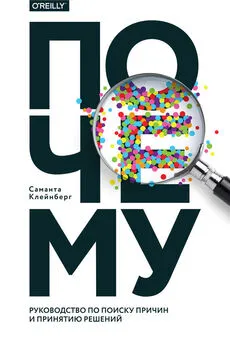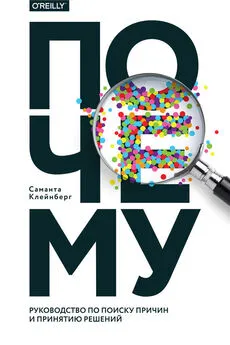Саманта Клейнберг - Почему
- Название:Почему
- Автор:
- Жанр:
- Издательство:Литагент МИФ без БК
- Год:2017
- Город:Москва
- ISBN:978-5-00100-593-3
- Рейтинг:
- Избранное:Добавить в избранное
-
Отзывы:
-
Ваша оценка:
Саманта Клейнберг - Почему краткое содержание
Книга будет интересна аналитикам, философам, исследователям, медикам, экономистам, юристам, начинающим ученым, всем, кто имеет дело с массивами данных и хочет научиться критическому мышлению.
На русском языке публикуется впервые.
Почему - читать онлайн бесплатно полную версию (весь текст целиком)
Интервал:
Закладка:
Joynson, R. B. (1971). Michotte’s experimental methods. British Journal of Psychology , 62(3): 293–302.
Kahneman, D., Lovallo, D., and Sibony, O. (2011). Before You Make That Big Decision… Harvard Business Review , 89(6): 50–60.
Kant, I. (1902). Prolegomena to Any Future Metaphysics . Open Court Publishing, Chicago. Translated by Paul Carus.
Kant, I. (1998). Critique of Pure Reason . Cambridge University Press, Cambridge. Translated by Paul Guyer and Allen W. Wood.
Kaptchuk, T. J., Friedlander, E., Kelley, J. M., Sanchez, M. N., Kokkotou, E., Singer, J. P., Kowalczykowski, M., Miller, F. G., Kirsch, I., and Lembo, A. J. (2010). Placebos without Deception: A Randomized Controlled Trial in Irritable Bowel Syndrome. PloS ONE , 5(12): e15591.
Kearney, M. S. and Levine, P. B. (2014). Media Influences on Social Outcomes: The Impact of MTV’s 16 and Pregnant on Teen Childbearing. Technical Report 19795, National Bureau of Economic Research.
Keeter, S., Dimock, M., and Christian, L. (2008). Calling Cell Phones in ’08 Pre-Election Polls. The Pew Research Center for the People and the Press .
Kiszko, K. M., Martinez, O. D., Abrams, C., and Elbel, B. (2014). The Influence of Calorie Labeling on Food Orders and Consumption: A Review of the Literature. Journal of Community Health , 39(6): 1248–1269.
Klein, R. A., Ratliff, K. A., Vianello, M., et al. (2014). Investigating Variation in Replicability. Social Psychology , 45(3): 142–152.
Kleinberg, S. (2012). Causality, Probability, and Time . Cambridge University Press, New York.
Kleinberg, S. and Elhadad, N. (2013). Lessons Learned in Replicating Data-Driven Experiments in Multiple Medical Systems and Patient Populations. In AMIA Annual Symposium .
Knobe, J. (2003). Intentional Action and Side Effects in Ordinary Language. Analysis , 63(279): 190–194.
Knobe, J. and Fraser, B. (2008). Causal Judgment and Moral Judgment: Two Experiments. In W. Sinnott-Armstrong (ed.), Moral Psychology , volume 2, pp. 441–448. The MIT Press, Cambridge, MA.
Knobe, J. and Mendlow, G. S. (2004). The Good, the Bad and the Blameworthy: Understanding the Role of Evaluative Reasoning in Folk Psychology. Journal of Theoretical and Philosophical Psychology , 24(2): 252–258.
Knobe, J. and Nichols, S. (2008). Experimental Philosophy . Oxford University Press, Oxford.
Koch, R. (1932). Die Aetiologie der Tuberkulose. Journal of Molecular Medicine , 11(12): 490–492.
Koppett, L. (1978). Carrying Statistics to Extremes. Sporting News .
Korja, M., Silventoinen, K., Laatikainen, T., Jousilahti, P., Salomaa, V., Hernes-niemi, J., and Kaprio, J. (2013). Risk Factors and Their Combined Effects on the Incidence Rate of Subarachnoid Hemorrhage – A Population-Based Cohort Study. PLoS ONE , 8(9): e73760.
Kravitz, R. L. and Duan, N. (eds.) (2014). Design and Implementation of N-of-1 Trials: A User’s Guide . Agency for Healthcare Research and Quality, Rockville, MD.
Krieger, J. and Saelens, B. E. (2013). Impact of Menu Labeling on Consumer Behavior: A 2008–2012 Update. Robert Wood Johnson Foundation .
Krueger, A. B. (2003). Economic Considerations and Class Size. The Economic Journal , 113(485): F34–F63.
Krueger, A. B. and Whitmore, D. M. (2001). The effect of attending a small class in the early grades on college-test taking and middle school test results: Evidence from Project STAR. The Economic Journal , 111(468): 1–28.
van Kuppeveld, F. J., de Jong, A. S., Lanke, K. H., Verhaegh, G. W., Melchers, W. J., Swanink, C. M., Bleijenberg, G., Netea, M. G., Galama, J. M., and van Der Meer, J. W. (2010). Prevalence of xenotropic murine leukaemia virus-related virus in patients with chronic fatigue syndrome in the Netherlands: Retrospective analysis of samples from an established cohort. BMJ , 340: c1018.
Kushnir, T. and Gopnik, A. (2005). Young Children Infer Causal Strength from Probabilities and Interventions. Psychological Science , 16(9): 678–683.
Kwiatkowski, D., Phillips, P. C., Schmidt, P., and Shin, Y. (1992). Testing the null hypothesis of stationarity against the alternative of a unit root: How sure are we that economic time series have a unit root? Journal of Econometrics , 54(1): 159–178.
Lagnado, D. A. and Channon, S. (2008). Judgments of cause and blame: The effects of intentionality and foreseeability. Cognition , 108(3): 754–770.
Lagnado, D. A. and Harvey, N. (2008). The impact of discredited evidence. Psychonomic Bulletin & Review , 15(6): 1166–1173.
Lagnado, D. A. and Sloman, S. (2004). The Advantage of Timely Intervention. Journal of Experimental Psychology: Learning, Memory, and Cognition , 30(4): 856–876.
Lagnado, D. A. and Sloman, S. A. (2006). Time as a Guide to Cause. Journal of Experimental Psychology: Learning, Memory, and Cognition , 32(3): 451–460.
Lagnado, D. A. and Speekenbrink, M. (2010). The Influence of Delays in Real-Time Causal Learning. The Open Psychology Journal , 3(2): 184–195.
Lagnado, D. A., Waldmann, M. R., Hagmayer, Y., and Sloman, S. A. (2007). Beyond Covariation. In A. Gopnik and L. Schulz (eds.), Causal learning: Psychology, Philosophy, and Computation , pp. 154–172. Oxford University Press, Oxford.
Lange, M. (2013). What Makes a Scientific Explanation Distinctively Mathematical? The British Journal for the Philosophy of Science , 64(3): 485–511.
Lazer, D. M., Kennedy, R., King, G., and Vespignani, A. (2014). The Parable of Google Flu: Traps in Big Data Analysis. Science , 343(6176): 1203–1205.
Leibovici, L. (2001). Effects of remote, retroactive intercessory prayer on outcomes in patients with bloodstream infection: Randomised controlled trial. BMJ , 323(7327): 1450–1451.
Leslie, A. M. (1982). The perception of causality in infants. Perception , 11(2): 173–186.
Leslie, A. M. and Keeble, S. (1987). Do six-month-old infants perceive causality? Cognition , 25(3): 265–288.
Lewis, D. (1973). Causation. The Journal of Philosophy , 70(17): 556–567. Reprinted in Lewis 1986a.
Lewis, D. (1976). The paradoxes of time travel. American Philosophical Quarterly , 13(2): 145–152.
Lewis, D. (1986a). Philosophical Papers , volume 2. Oxford University Press, Oxford.
Lewis, D. (1986b). Postscripts to “Causation”. In Philosophical Papers , vol. 2, pp. 172–213. Oxford University Press, Oxford.
Lewis, D. (2000). Causation as Influence. The Journal of Philosophy , 97(4): 182–197.
Lin, P. and Gill, J. R. (2009). Delayed Homicides and the Proximate Cause. American Journal of Forensic Medicine & Pathology , 30(4): 354–357.
Lind, J. (1757). A Treatise on the Scurvy: In Three Parts, Containing an Inquiry Into the Nature, Causes, and Cure, of that Disease . A. Millar, London.
Linthwaite, S. and Fuller, G. N. (2013). Milk, chocolate and Nobel prizes. Practical Neurology , 13(1):63–63.
Lo, S.-C., Pripuzova, N., Li, B., Komaroff, A. L., Hung, G.-C., Wang, R., and Alter, H. J. (2010). Detection of MLV-related virus gene sequences in blood of patients with chronic fatigue syndrome and healthy blood donors. Proceedings of the National Academy of Sciences , 107(36): 15874–15879.
Lo, S.-C., Pripuzova, N., Li, B., Komaroff, A. L., Hung, G.-C., Wang, R., and Alter, H. J. (2012). Retraction for Lo et al., Detection of MLV-related virus gene sequences in blood of patients with chronic fatigue syndrome and healthy blood donors. Proceedings of the National Academy of Sciences , 109(1): 346–346.
Lombardi, V. C., Ruscetti, F. W., Gupta, J. D., Pfost, M. A., Hagen, K. S., Peterson, D. L., Ruscetti, S. K., Bagni, R. K., Petrow-Sadowski, C., Gold, B., Dean, M., Silverman, R. H., and Mikovits, J. A. (2009). Detection of an Infectious Retrovirus, XMRV, in Blood Cells of Patients with Chronic Fatigue Syndrome. Science , 326(5952): 585–589.
Lopes, L. (1993). Two conceptions of the juror. In R. Hastie (ed.), Inside the Juror: The Psychology of Juror Decision Making , pp. 255–262. Cambridge University Press, Cambridge.
Machamer, P., Darden, L., and Craver, C. F. (2000). Thinking about Mechanisms. Philosophy of Science , 67(1): 1–25.
Mackie, J. L. (1974). The Cement of the Universe . Clarendon Press, Oxford.
Macklin, R. (1999). The Ethical Problems with Sham Surgery in Clinical Research. The New England Journal of Medicine , 341(13): 992–996.
Malle, B. F., Guglielmo, S., and Monroe, A. E. (2014). A Theory of Blame. Psychological Inquiry: An International Journal for the Advancement of Psychological Theory , 25(2): 147–186.
Mandel, D. R. (2003). Judgment Dissociation Theory: An Analysis of Differences in Causal, Counterfactual, and Covariational Reasoning. Journal of Experimental Psychology: General , 132(3): 419–434.
March, L., Irwig, L., Schwarz, J., Simpson, J., Chock, C., and Brooks, P. (1994). n of 1 trials comparing a non-steroidal anti-inflammatory drug with paracetamol in osteoarthritis. BMJ , 309(6961): 1041–1045.
Matossian, M. A. K. (1989). Poisons of the Past: Molds, Epidemics, and History . Yale University Press, New Haven, CT.
Matthews, R. (2000). Storks Deliver Babies (p=0.008). Teaching Statistics , 22(2): 36–38.
Maurage, P., Heeren, A., and Pesenti, M. (2013). Does Chocolate Consumption Really Boost Nobel Award Chances? The Peril of Over-Interpreting Correlations in Health Studies. The Journal of Nutrition , 143(6): 931–933.
McLean, K. A., Byanaku, A., Kubikonse, A., Tshowe, V., Katensi, S., and Lehman, A. G. (2014). Fishing with bed nets on Lake Tanganyika: A randomized survey. Malaria Journal , 13: 395.
McLean, R. D. and Pontiff, J. (2015). Does Academic Research Destroy Stock Return Predictability? Journal of Finance , forthcoming. Retrieved from http://ssrn.com/abstract=2156623 .
Meadow, R. (2002). A case of murder and the BMJ. BMJ , 324(7328): 41–43.
Meek, C. (1995). Strong completeness and faithfulness in Bayesian networks. In Proceedings of the Eleventh Conference on Uncertainty in Artificial Intelligence .
Meeks, R. R. (2004). Unintentionally Biasing the Data: Reply to Knobe. Journal of Theoretical and Philosophical Psychology , 24(2): 220–223.
Messerli, F. H. (2012). Chocolate Consumption, Cognitive Function, and Nobel Laureates. The New England Journal of Medicine , 367(16): 1562–1564.
Michotte, A. (1946). La Perception de la Causalité . Editions de l’Institut Supйrieur de Philosophie, Louvain. English translation by T. Miles & E. Miles. The Perception of Causality , Basic Books, 1963. Citations refer to the translated edition.
Mill, J. S. (1843). A System of Logic . Parker, London. Reprint, Lincoln-Rembrandt Pub., 1986.
Miller, J. G. (1984). Culture and the Development of Everyday Social Explanation. Journal of Personality and Social Psychology , 46(5): 961–978.
Mitofsky, W. J. (1998). Review: Was 1996 a Worse Year for Polls Than 1948? The Public Opinion Quarterly , 62(2): 230–249.
Mitsumoto, H., Brooks, B. R., and Silani, V. (2014). Clinical trials in amyotrophic lateral sclerosis: Why so many negative trials and how can trials be improved? The Lancet Neurology , 13(11): 1127–1138.
Читать дальшеИнтервал:
Закладка:






![Саманта Даунинг - Моя дорогая жена [litres]](/books/1070823/samanta-dauning-moya-dorogaya-zhena-litres.webp)



